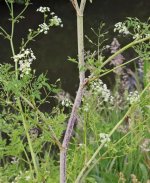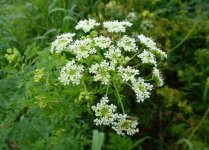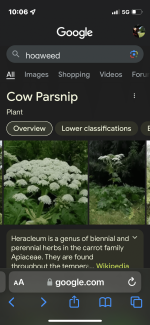invent4hir
Bronze Member
- Aug 1, 2017
- 1,802
- 2,748
- 🏆 Honorable Mentions:
- 3
- Detector(s) used
- Whites V3i & DFX
- Primary Interest:
- All Treasure Hunting
All, please take note. I was chopping down a bunch of this weed at a permission a couple weeks ago not knowing it is highly poisonous!
COLUMBUS, Ohio (WCMH) – The plant that is said to have been used to execute Socrates could also be in your backyard, as the highly poisonous plant continues to spread throughout Ohio.
Poison Hemlock is a flowering plant that is part of the carrot family and can be fatal if ingested by humans or animals. Chief Botanist with the Ohio Department of Natural Resources Richard Gardner said the non-native plant, which was relatively rare until about 30 years ago, is becoming more common and spreading throughout the state.
“It’s been in Ohio as early as the mid-1850s at least, brought in as an ornamental plant because of its unique foliage and white flowers,” Gardner said. “It was actually planted in people’s landscaping, and it has been spreading.”
The biennial plant has fern-like leaves and white flowers, which usually begin to bloom between June and August. It can grow up to 10 feet tall, but more commonly grows to around six to eight feet, according to Gardner.
Poison Hemlock typically grows along fence lines, in irrigation ditches and in moist environments. The plant can be found in every state in the country, with the exception of Alaska, Florida, Hawaii and Mississippi, according to the United States Department of Agriculture.
“Poison hemlock likes full sun but can grow in partial shade,” Gardner said. “It can’t handle extremely dry, well-drained soil.”
In Ohio, the poisonous plant is most abundant in the western part of the state, but it has now spread to all 88 counties. The plant could be confused for parsley or wild carrot, Gardner said, but ingesting it could be a fatal mistake.
“This is a very deadly plant,” Gardner said. “It has alkaloids in its sap to protect it from things eating it – herbivores. All parts of the plant are poisonous, so you don’t want to ingest any of it.”
Eating any part of the plant can result in it attacking one’s nervous system and heart, according to Gardner. Most of the time, hemlock is only poisonous if ingested and people will not get a rash from touching it, according to the Cleveland Clinic. But even without eating the plant, Gardner said there are other ways one could suffer from a reaction, so people should be cautious around it.
“If you’re cutting it and the sap flies into your eyes or if you have a cut or something and the sap gets in the cut, you certainly can have a reaction to it,” Gardner said. “If you’re chopping it down or mowing through it the sap can get airborne and can go through your nose or mouth.”
If someone thinks they may have ingested the poisonous plant, Gardner said they should go to the emergency room.
In more severe cases, hemlock poisoning can cause delayed symptoms such as slow heartbeat, low blood pressure, muscle paralysis, muscle breakdown, muscle death, kidney failure and central nervous symptom depression.
For those with livestock or pets, symptoms of hemlock poisoning typically appear within an hour after the plant is ingested, and animals can die from respiratory paralysis within two to three hours, according to the USDA.
Signs an animal has ingested the plant include trembling, salivation and frothing, lack of coordination, dilated pupils, rapid pulse and convulsions.
Small infestations of poison hemlock can be removed by hand. It is strongly recommended that hands are protected with gloves, arms are protected with long sleeves and eyes are protected with safety goggles, according to Ohio State University. Plants should be dug out, with the entire root removed. The plants should then be placed in a plastic bag in the trash.
Herbicides are likely the safest option for removal. The non-native weed is susceptible to a wide range of herbicides – Crossbow and Remedy Ultra has the best rating for controlling poison hemlock, followed by glyphosate (Roundup), dicamba and Cimarron Max, according to OSU.
Source: https://www.wdtn.com/news/ohio/how-...ly-poisonous-plant-spreading-throughout-ohio/
COLUMBUS, Ohio (WCMH) – The plant that is said to have been used to execute Socrates could also be in your backyard, as the highly poisonous plant continues to spread throughout Ohio.
Poison Hemlock is a flowering plant that is part of the carrot family and can be fatal if ingested by humans or animals. Chief Botanist with the Ohio Department of Natural Resources Richard Gardner said the non-native plant, which was relatively rare until about 30 years ago, is becoming more common and spreading throughout the state.
“It’s been in Ohio as early as the mid-1850s at least, brought in as an ornamental plant because of its unique foliage and white flowers,” Gardner said. “It was actually planted in people’s landscaping, and it has been spreading.”
The biennial plant has fern-like leaves and white flowers, which usually begin to bloom between June and August. It can grow up to 10 feet tall, but more commonly grows to around six to eight feet, according to Gardner.
Poison Hemlock typically grows along fence lines, in irrigation ditches and in moist environments. The plant can be found in every state in the country, with the exception of Alaska, Florida, Hawaii and Mississippi, according to the United States Department of Agriculture.
“Poison hemlock likes full sun but can grow in partial shade,” Gardner said. “It can’t handle extremely dry, well-drained soil.”
In Ohio, the poisonous plant is most abundant in the western part of the state, but it has now spread to all 88 counties. The plant could be confused for parsley or wild carrot, Gardner said, but ingesting it could be a fatal mistake.
“This is a very deadly plant,” Gardner said. “It has alkaloids in its sap to protect it from things eating it – herbivores. All parts of the plant are poisonous, so you don’t want to ingest any of it.”
Eating any part of the plant can result in it attacking one’s nervous system and heart, according to Gardner. Most of the time, hemlock is only poisonous if ingested and people will not get a rash from touching it, according to the Cleveland Clinic. But even without eating the plant, Gardner said there are other ways one could suffer from a reaction, so people should be cautious around it.
“If you’re cutting it and the sap flies into your eyes or if you have a cut or something and the sap gets in the cut, you certainly can have a reaction to it,” Gardner said. “If you’re chopping it down or mowing through it the sap can get airborne and can go through your nose or mouth.”
If someone thinks they may have ingested the poisonous plant, Gardner said they should go to the emergency room.
Symptoms of hemlock poisoning
Symptoms of hemlock poisoning can occur almost immediately after ingesting the plant, according to the Cleveland Clinic. Symptoms include sweating, vomiting, dilated pupils, excess salivation, dry mouth, rapid heartbeat, restlessness, confusion, muscle weakness, twitches, tremors and seizures.In more severe cases, hemlock poisoning can cause delayed symptoms such as slow heartbeat, low blood pressure, muscle paralysis, muscle breakdown, muscle death, kidney failure and central nervous symptom depression.
For those with livestock or pets, symptoms of hemlock poisoning typically appear within an hour after the plant is ingested, and animals can die from respiratory paralysis within two to three hours, according to the USDA.
Signs an animal has ingested the plant include trembling, salivation and frothing, lack of coordination, dilated pupils, rapid pulse and convulsions.
How to remove the plant from your property
State law mandates that property owners cut or destroy prohibited noxious weeds, including poison hemlock.Small infestations of poison hemlock can be removed by hand. It is strongly recommended that hands are protected with gloves, arms are protected with long sleeves and eyes are protected with safety goggles, according to Ohio State University. Plants should be dug out, with the entire root removed. The plants should then be placed in a plastic bag in the trash.
Herbicides are likely the safest option for removal. The non-native weed is susceptible to a wide range of herbicides – Crossbow and Remedy Ultra has the best rating for controlling poison hemlock, followed by glyphosate (Roundup), dicamba and Cimarron Max, according to OSU.
Source: https://www.wdtn.com/news/ohio/how-...ly-poisonous-plant-spreading-throughout-ohio/
Attachments
Upvote
6










 [rhetorical--I don't expect there's a correct answer, BICBW]
[rhetorical--I don't expect there's a correct answer, BICBW]


